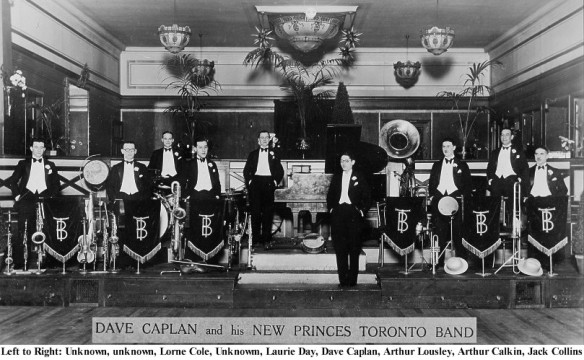By Margaret Ashburner
1920s Toronto was a busy time and place for the working musician. Dance bands were performing regularly, and multi-instrumentalists would have been in high demand. One such musician was Hal Swain who started his own ensemble with a number of local musicians including Les Allen, who had equally diverse abilities. These ambitious musicians hoped to make a name for themselves; Allen described the group as “a combination of mostly youngsters, all as keen as mustard” (Litchfield, p. 513).

Les Allen, Roll Back the Years, p. 249.Les ù

Hal Swain, Roll Back the Years, p. 249.
Spotted by a recruiter the two were singled out for their strong performing abilities and asked to form a group that would perform at the Rector’s Club in London, England. Of this time, Swain declared his intention “…to feature the fact that they were from the Dominion and discover if the dancers in the empire’s greatest city would evince the same interest in a jazz band from Toronto as they would in a New York importation” (Mark Miller, p. 112).
This group of proud Canadians sailed for England following the instructions of the London recruiter. However when they arrived, they found that the Rector’s Club had closed. The recruiter must have felt responsible for the fiasco and made alternate arrangements for the Canadians to audition at the New Princes’ restaurant. They were hired to play and remained for two years—taking the band name from the restaurant’s name.

Dave Caplan and his New Princes’ Toronto Band (Left to right: unknown, unknown, Lorne Cole, unknown, Laurie Day, Dave Caplan, Arthur Lousley, Arthur Calkin, Jack Collins (The British Dance Band Encyclopaedia)
The New Princes’ Toronto Band was composed of gigging musicians, and as a result, saw regular changes in personnel as opportunities arose. People came and left over the years and there were several iterations of the band’s name as band leaders changed or some of the musicians formed other groups. Musicologists generally consider these different iterations to be the same band. Some of the key Canadian musicians in this group were Hal Swain, Dave Caplan, Les Allen and Art Christmas.
Library and Archives Canada (LAC) is pleased to have digitized some recordings from a set of recently acquired discs. This sampling includes songs that were mainly recorded from September to November 1926 when the band was called Dave Caplan’s Toronto Band.
“Up and At ‘Em”

“Up and At ‘Em” by Dave Caplan’s Toronto Band, 1926 (AMICUS 45168615)
[Listen to “Up and At ‘Em”] Recorded by Dave Caplan’s Toronto Band in November 1926, this piece is a lively foxtrot, one of the most popular dance forms of the time. This performance, like most jazz recordings of the time, includes several solos, likely improvised, from each band member. The raunchy trombone and light pattering percussion solos are particularly enjoyable.
“I Never See Maggie Alone”

”I Never See Maggie Alone” by Dave Caplan’s Toronto Band, 1926 (AMICUS 45168601)
[Listen to “I Never See Maggie Alone”] A comedic song about a young man lamenting the ever-looming presence of his girlfriend’s family. At first the family turns up on the couple’s dates, but as the song progresses they appear in increasingly improbable situations including being stowed away in the hood of the car, lurking in the lake where the couple is fishing and eerily appearing when the lights are turned off and then on. Really, it walks a fine line between horror and comedy! The vocals in this performance are likely Hal Swain or Les Allen and show some excellent comedic timing.
“While the Sahara Sleeps”

“While the Sahara Sleeps” by Dave Caplan’s Toronto Band, 1926 (AMICUS 45168382)
[Listen to “While the Sahara Sleeps”] Fantastic brass playing with a great trumpet solo full of an idiomatic flutter tongue that is characteristic of jazz from this time.
“High Fever”

“High Fever” by Dave Caplan’s Toronto Band, 1926 (AMICUS 45168455)
[Listen to “High Fever”] Another foxtrot from the Dave Caplan Toronto Band, this one a little more mellow than “Up and At ‘Em” but still a cheerful and upbeat foxtrot sound. Several jolly piano solos interject from the band’s pianist Laurie Day as well as some playful trombone solos towards the end.
“Say That You Love Me”

“Say That You Love Me” by Dave Caplan’s Toronto Band, 1926 (AMICUS 45168037)
[Listen to “Say That You Love Me” by Deutschen Grammophon or “Say That You Love Me” by Polydor] The only waltz among this set—as the title suggests, this tune is schmaltzy, romantic and like most of big band music, pleasingly over the top. Halfway through the recording, we hear Les Allen add some vocals ending with the lyrics, “Say that you love me—I love you!” The disc was distributed by Deutschen Grammophon-Aktiengesellschaft and a second recording (instrumental only) from Polydor has also been digitized.

The Polydor release of “Say That You Love Me” by Dave Caplan’s Toronto Band, 1926 (AMICUS 45168371)
Head on over to the Virtual Gramophone to peruse other music from the same era.
Sources
- Litchfield, Jack. The Canadian Jazz Discography 1916-1980. Toronto: University of Toronto Press, 1982
- Miller, Eugene. “Les Allen.” The Canadian Encyclopedia.
- Miller, Mark. Such Melodious Racket: the Lost History of Jazz in Canada, 1914-1949. Toronto: Mercury Press, 1997.
- Moogk, Edward. Roll Back the Years: History of Canadian Recorded Sound and Its Legacy: Genesis to 1930. National Library of Canada, 1975.
- Thomas, Mike. The British Dance Band Encyclopaedia.
Margaret Ashburner is the Special Collections Librarian of the retrospective music collection at Library and Archives Canada.




